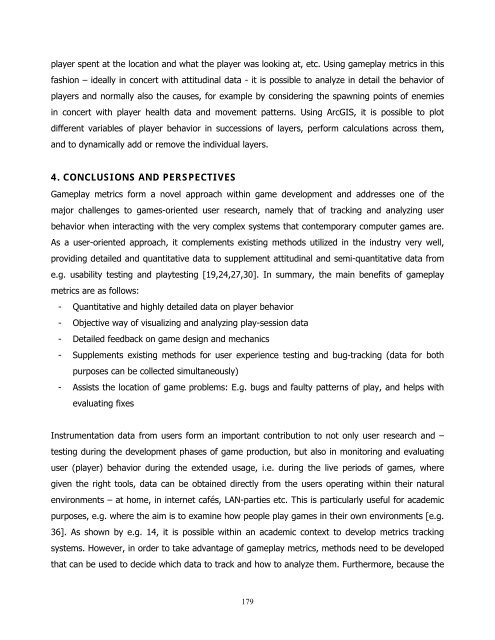Play-Persona: Modeling Player Behaviour in Computer Games
Play-Persona: Modeling Player Behaviour in Computer Games
Play-Persona: Modeling Player Behaviour in Computer Games
You also want an ePaper? Increase the reach of your titles
YUMPU automatically turns print PDFs into web optimized ePapers that Google loves.
player spent at the location and what the player was look<strong>in</strong>g at, etc. Us<strong>in</strong>g gameplay metrics <strong>in</strong> this<br />
fashion – ideally <strong>in</strong> concert with attitud<strong>in</strong>al data - it is possible to analyze <strong>in</strong> detail the behavior of<br />
players and normally also the causes, for example by consider<strong>in</strong>g the spawn<strong>in</strong>g po<strong>in</strong>ts of enemies<br />
<strong>in</strong> concert with player health data and movement patterns. Us<strong>in</strong>g ArcGIS, it is possible to plot<br />
different variables of player behavior <strong>in</strong> successions of layers, perform calculations across them,<br />
and to dynamically add or remove the <strong>in</strong>dividual layers.<br />
4. CONCLUSIONS AND PERSPECTIVES<br />
Gameplay metrics form a novel approach with<strong>in</strong> game development and addresses one of the<br />
major challenges to games-oriented user research, namely that of track<strong>in</strong>g and analyz<strong>in</strong>g user<br />
behavior when <strong>in</strong>teract<strong>in</strong>g with the very complex systems that contemporary computer games are.<br />
As a user-oriented approach, it complements exist<strong>in</strong>g methods utilized <strong>in</strong> the <strong>in</strong>dustry very well,<br />
provid<strong>in</strong>g detailed and quantitative data to supplement attitud<strong>in</strong>al and semi-quantitative data from<br />
e.g. usability test<strong>in</strong>g and playtest<strong>in</strong>g [19,24,27,30]. In summary, the ma<strong>in</strong> benefits of gameplay<br />
metrics are as follows:<br />
- Quantitative and highly detailed data on player behavior<br />
- Objective way of visualiz<strong>in</strong>g and analyz<strong>in</strong>g play-session data<br />
- Detailed feedback on game design and mechanics<br />
- Supplements exist<strong>in</strong>g methods for user experience test<strong>in</strong>g and bug-track<strong>in</strong>g (data for both<br />
purposes can be collected simultaneously)<br />
- Assists the location of game problems: E.g. bugs and faulty patterns of play, and helps with<br />
evaluat<strong>in</strong>g fixes<br />
Instrumentation data from users form an important contribution to not only user research and –<br />
test<strong>in</strong>g dur<strong>in</strong>g the development phases of game production, but also <strong>in</strong> monitor<strong>in</strong>g and evaluat<strong>in</strong>g<br />
user (player) behavior dur<strong>in</strong>g the extended usage, i.e. dur<strong>in</strong>g the live periods of games, where<br />
given the right tools, data can be obta<strong>in</strong>ed directly from the users operat<strong>in</strong>g with<strong>in</strong> their natural<br />
environments – at home, <strong>in</strong> <strong>in</strong>ternet cafés, LAN-parties etc. This is particularly useful for academic<br />
purposes, e.g. where the aim is to exam<strong>in</strong>e how people play games <strong>in</strong> their own environments [e.g.<br />
36]. As shown by e.g. 14, it is possible with<strong>in</strong> an academic context to develop metrics track<strong>in</strong>g<br />
systems. However, <strong>in</strong> order to take advantage of gameplay metrics, methods need to be developed<br />
that can be used to decide which data to track and how to analyze them. Furthermore, because the<br />
179















